|
Sunday:
January 12, 2003 | |
0500 GMT |
 |
New type of star identified
A new type of star has been discovered lurking as a low mass component in a very compact binary star system. Astronomers announced that they have confirmed the existence of a new variety of stellar end-product. This previously unknown type of star has some properties similar to brown dwarf stars and may help astronomers understand some of the recently discovered extra-solar planets in close proximity to their suns.
 FULL STORY FULL STORY
 |  |
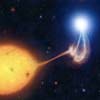
|
 |
Distant ring of stars found around the Milky Way
A previously unseen band of stars beyond the edge of the Milky Way galaxy has been discovered by a team of scientists. The discovery could help to explain how the galaxy was assembled 10 billion years ago.
 FULL STORY FULL STORY
 |  |
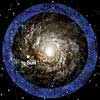
|
 |
|
Saturday:
January 11, 2003 | |
0500 GMT |
 |
Delta 2 ready to go today
Topped with a pair of NASA scientific spacecraft with vastly different missions, a Boeing Delta 2 rocket is slated for launch at 7:45 p.m. EST today from Vandenberg Air Force Base in California.
 MISSION STATUS CENTER - updates! MISSION STATUS CENTER - updates!
 LAUNCH EVENTS TIMELINE LAUNCH EVENTS TIMELINE
 GROUND TRACKING MAP GROUND TRACKING MAP
 |  |

|
 |

Video coverage for subscribers only:
 VIDEO: WATCH FRIDAY'S PRE-LAUNCH NEWS CONFERENCE QT or RV VIDEO: WATCH FRIDAY'S PRE-LAUNCH NEWS CONFERENCE QT or RV
 VIDEO: NARRATED OVERVIEW OF THE ICESAT MISSION QT or RV VIDEO: NARRATED OVERVIEW OF THE ICESAT MISSION QT or RV
 VIDEO: COMMENTS FROM ICESAT PROJECT SCIENTIST QT or RV VIDEO: COMMENTS FROM ICESAT PROJECT SCIENTIST QT or RV
 VIDEO: ANIMATION OF CHIPSAT ORBITING EARTH QT or RV VIDEO: ANIMATION OF CHIPSAT ORBITING EARTH QT or RV
 VIDEO: COMMENTS FROM CHIPSAT PRINCIPAL INVESTIGATOR QT or RV VIDEO: COMMENTS FROM CHIPSAT PRINCIPAL INVESTIGATOR QT or RV
 SUBSCRIBE NOW SUBSCRIBE NOW

|
Did big burp interrupt moon's early history?
Using a state-of-the-art computer model of the lunar interior, geophysicists at the University of California, Berkeley, have shown that a mighty burp early in the moon's history could account for some of its geologic mysteries.
 FULL STORY FULL STORY
 |  |

|
 |
|
Friday:
January 10, 2003 | |
0124 GMT |
 |
Shuttle launch hinges on cracked bearing issue
NASA managers have scheduled a teleconference Sunday, hours before the start of the shuttle Columbia's countdown to blastoff Thursday on a microgravity research mission, to assess the health of critical bearings in the ship's fuel lines.
 FULL STORY FULL STORY
 |  |

|
 |
Astronomers glimpse feeding of a galactic dragon
The most detailed view yet of the fuel that feeds a monstrous black hole in the center of a remote quasar galaxy has recently been obtained. A team of radio astronomers has found a cold ring of gas around a supermassive black hole in the fiery nuclear region of quasar galaxy QSO I Zw 1.
 FULL STORY FULL STORY
 |  |

|
 |
Scientists witness end of the 'Dark Ages'
Researchers using NASA's Hubble Space Telescope reported Thursday they are seeing the conclusion of the cosmic epoch called the "Dark Ages," a time about a billion years after the Big Bang, when newly-formed stars and galaxies were just starting to become visible.
 FULL STORY FULL STORY
 |  |

|
 |
|
Thursday:
January 9, 2003 | |
0500 GMT |
 |
Two NASA craft will share weekend rocket launch
NASA is launching a pair of modest but scientifically ambitious satellites Saturday to answer fundamental questions about the forces shaping Earth's environment, from the surface of the planet to the depths of interstellar space.
 FULL STORY FULL STORY
 MISSION STATUS CENTER MISSION STATUS CENTER
 |  |

|
 |
First Neptune Trojan found
Astronomers have discovered a small body orbiting the Sun at the distance of Neptune whose orbit makes it the first known member of a long-sought population of objects known as Neptune Trojans. This small body is known as 2001 QR322.
 FULL STORY FULL STORY
 |  |

|
 |
Speed of gravity measured for first time
Taking advantage of a rare cosmic alignment, scientists have made the first measurement of the speed at which the force of gravity propagates, giving a numerical value to one of the last unmeasured fundamental constants of physics.
 FULL STORY FULL STORY
 |  |
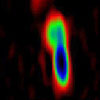
|
 |
|
Wednesday:
January 8, 2003 | |
0257 GMT |
 |
Biggest zoom lens in space extends Hubble's reach
The Advanced Camera for Surveys, aboard NASA's Hubble Space Telescope, has used a natural "zoom lens" in space to boost its view of the distant universe. Besides offering an unprecedented and dramatic new view of the cosmos, the results promise to shed light on galaxy evolution and dark matter in space.
 FULL STORY FULL STORY
 |  |

|
 |
Farthest known planet discovered
Astronomers from the Harvard-Smithsonian Center for Astrophysics have detected the most distant extrasolar planet ever found in the constellation Sagittarius using a new method that could lead to the discovery of Earth-like worlds around nearby stars.
 FULL STORY FULL STORY
 |  |

|
 |
Pettit replaces Budarin for space station spacewalk
Astronaut Donald Pettit will replace cosmonaut Nikolai Budarin for a planned 6.5-hour spacewalk Jan. 15 with space station commander Kenneth Bowersox, NASA announced Tuesday. Budarin was declared ineligible for spacewalk duty because of an undisclosed medical issue.
 FULL STORY FULL STORY
 |  |
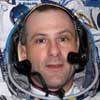
|
 |
Hubble reveals complex circumstellar disk
Hubble Space Telescope's new Advanced Camera for Surveys has given astronomers their clearest view yet of the dust disk around a young, 5-million-year-old star. Such disks are expected to be the birthplace of planets.
 FULL STORY FULL STORY
 |  |
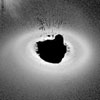
|
 |
Nozzle failure doomed Ariane 5 rocket
In its report issued Monday, the board investigating the December 11 failure of Arianespace's Ariane 5 rocket concluded that the rocket went out of control because of a leak in the Vulcain 2 main engine's nozzle. Read the Arianespace statement:
 FULL STORY FULL STORY
 |  |

|
 |
|
Tuesday:
January 7, 2003 | |
0041 GMT |
 |
Coriolis launched to track ocean winds, solar storms
Finally winning the battle against weather and technical glitches that delayed the mission into the new year, a Titan 2 rocket successfully lofted the U.S. military's Coriolis research satellite into orbit Monday to mark the first space launch of 2003.
 FULL STORY FULL STORY
 MISSION STATUS CENTER MISSION STATUS CENTER
 LAUNCH EVENTS TIMELINE LAUNCH EVENTS TIMELINE
 TITAN 2 ROCKET FACT SHEET TITAN 2 ROCKET FACT SHEET
 OVERVIEW OF CORIOLIS OVERVIEW OF CORIOLIS
 |  |
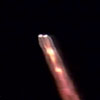
|
 |
Milky Way monster stars in cosmic reality show
The longest X-ray look at the supermassive black hole at the Milky Way's center has given astronomers unprecedented access to its life and times. The new data from NASA's Chandra X-ray Observatory revealed that our galaxy's central black hole is a frequent "bad actor," prone to numerous outbursts and occasional large explosions.
 FULL STORY FULL STORY
 |  |
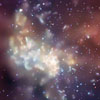
|
 |
Astronomers find a hero
Heroes are usually confined to comic books and movies, but as the saying goes, we all need one. So astronomers have turned to the deep, dark cosmos to find their heroic figure - the "Hyper Extremely Red Object," or "Hero."
 FULL STORY FULL STORY
 |  |
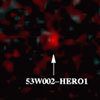
|
 |
|
Monday:
January 6, 2003 | |
0001 GMT |
 |
New lower limit for age of universe claimed
Cosmologists have continued efforts to refine the age of the universe by using new information from a variety of sources to calculate a new lower age limit that is 1.2 billion years higher than previous age limits. The new information lends new support to the potential presence of a strange new form of energy that dominates approximately 95 percent of the universe and causes its expansion to accelerate.
 FULL STORY FULL STORY
 |  |

|
 |
Chinese Shenzhou 4 capsule returns to Earth
In what many believe is the final unmanned test flight of China's manned space program, Shenzhou 4 touched down Sunday at the end of a week-long mission that by all accounts went smoothly.
 FULL STORY FULL STORY
 |  |
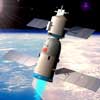
|
 |


 This exceptional chronicle of the historic Apollo 11 lunar landing mission features new digital transfers of film and television coverage unmatched by any other.
This exceptional chronicle of the historic Apollo 11 lunar landing mission features new digital transfers of film and television coverage unmatched by any other.